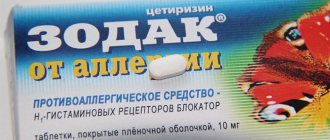Zyrtec
Antiallergic drug. Histamine H1 receptor blocker, competitive histamine antagonist, hydroxyzine metabolite. Prevents the development and facilitates the course of allergic reactions, has antipruritic and antiexudative effects.
Affects the early histamine-dependent stage of allergic reactions, limits the release of inflammatory mediators at the late stage of the allergic reaction, reduces the migration of eosinophils, neutrophils and basophils, stabilizes mast cell membranes. Reduces capillary permeability, prevents the development of tissue edema, relieves spasm of smooth muscles. Eliminates skin reactions to the introduction of histamine, specific allergens, as well as to cooling (with “cold” urticaria). Reduces histamine-induced bronchoconstriction in mild bronchial asthma.
It has virtually no anticholinergic and antiserotonin effects. In therapeutic doses it has virtually no sedative effect.
After a single dose of cetirizine at a dose of 10 mg, the onset of effect is observed after 20 minutes (in 50% of patients) and after 60 minutes (in 95% of patients), the effect lasts more than 24 hours. During a course of treatment, tolerance to the antihistamine effect of cetirizine does not develop. After stopping treatment, the effect lasts up to 3 days.
Pharmacokinetics
The pharmacokinetic parameters of cetirizine change linearly.
Suction
After oral administration, the drug is quickly and completely absorbed from the gastrointestinal tract. In adults, after a single dose of the drug in a therapeutic dose, Cmax in plasma is reached after 1±0.5 hours and is 300 ng/ml. Taking the drug with food does not affect the amount of absorption.
Distribution
Cetirizine binds to plasma proteins by 93±0.3%. Vd - 0.5 l/kg.
When taking the drug at a dose of 10 mg for 10 days, no accumulation of cetirizine is observed.
Metabolism
In small quantities, it is metabolized in the liver by O-dealkylation to form a pharmacologically inactive metabolite (unlike other histamine H1 receptor blockers, which are metabolized in the liver with the participation of isoenzymes of the cytochrome P450 system).
Removal
T1/2 in adults is approximately 10 hours. Approximately 2/3 of the dose taken is excreted unchanged by the kidneys.
Pharmacokinetics in special clinical situations
T1/2 in children aged 6-12 years - 6 hours; for children 2-6 years old - 5 hours; for children aged 6 months to 2 years - 3.1 hours.
In elderly patients and patients with chronic liver diseases, with a single dose of 10 mg, T1/2 increases by approximately 50%, and systemic clearance decreases by 40%.
In patients with mild renal failure (creatinine clearance > 40 ml/min), pharmacokinetic parameters are similar to those in patients with normal renal function.
In patients with moderate renal failure and in patients on hemodialysis (creatinine clearance <7 ml/min), when taking the drug orally at a dose of 10 mg, T1/2 increases 3 times, and total clearance decreases by 70% compared to patients with normal renal function, which requires a corresponding change in the dosage regimen.
Cetirizine is practically not removed from the body during hemodialysis.
Zyrtec 10 mg/ml drops for oral administration, 20 ml dropper bottle
Registration Certificate Holder
UCB FARCHIM (Switzerland)
Dosage form
Medicine - Zyrtec®
Description
Drops for oral administration
colorless, transparent, with the smell of acetic acid.
1 ml
Cetirizine dihydrochloride 10 mg
Excipients
: glycerol, propylene glycol, sodium saccharinate, methylparabenzene, propylparabenzene, sodium acetate, glacial acetic acid, purified water.
10 ml - dark glass dropper bottle (1) - cardboard packs. 20 ml - dark glass dropper bottle (1) - cardboard packs.
Indications
- treatment of symptoms of year-round and seasonal allergic rhinitis and allergic conjunctivitis, such as itching, sneezing, rhinorrhea, lacrimation, conjunctival hyperemia;
- hay fever (hay fever);
- urticaria (including chronic idiopathic urticaria);
- Quincke's edema;
- other allergic dermatoses (including atopic dermatitis), accompanied by itching and rashes.
Contraindications for use
- end-stage renal failure (CC < 10 ml/min);
- pregnancy;
- lactation period (breastfeeding);
- hereditary galactose intolerance, lactase deficiency or glucose-galactose malabsorption syndrome;
- children under 6 years of age (for tablets);
- children up to 6 months (for drops);
- hypersensitivity to the components of the drug;
- hypersensitivity to hydroxyzine.
Carefully
The drug should be prescribed for chronic renal failure (correction of the dosage regimen is required), for chronic liver diseases, and for elderly patients (due to a possible decrease in glomerular filtration).
pharmachologic effect
Antiallergic drug. Histamine H1 receptor blocker, competitive histamine antagonist, hydroxyzine metabolite. Prevents the development and facilitates the course of allergic reactions, has antipruritic and antiexudative effects.
Affects the early histamine-dependent stage of allergic reactions, limits the release of inflammatory mediators at the late stage of the allergic reaction, reduces the migration of eosinophils, neutrophils and basophils, stabilizes mast cell membranes. Reduces capillary permeability, prevents the development of tissue edema, relieves spasm of smooth muscles. Eliminates skin reactions to the introduction of histamine, specific allergens, as well as to cooling (with “cold” urticaria). Reduces histamine-induced bronchoconstriction in mild bronchial asthma.
It has virtually no anticholinergic and antiserotonin effects. In therapeutic doses it has virtually no sedative effect.
After a single dose of cetirizine at a dose of 10 mg, the onset of effect is observed after 20 minutes (in 50% of patients) and after 60 minutes (in 95% of patients), the effect lasts more than 24 hours. During a course of treatment, tolerance to the antihistamine effect of cetirizine does not develop. After stopping treatment, the effect lasts up to 3 days.
Drug interactions
When studying the drug interactions of cetirizine with pseudoephedrine, cimetidine, ketoconazole, erythromycin, azithromycin, glipizide and diazepam, no clinically significant adverse interactions were identified.
When administered simultaneously with theophylline (400 mg/day), the total clearance of cetirizine is reduced by 16% (the kinetics of theophylline does not change).
When administered simultaneously with macrolides and ketoconazole, no changes were noted on the ECG.
When using the drug in therapeutic doses, no data on interaction with alcohol (at a blood alcohol concentration of 0.5 g/l) were obtained. However, the patient should refrain from drinking alcohol during drug therapy to avoid depression of the central nervous system.
Dosage regimen
The drug is prescribed orally.
Adults and children over 6 years old
prescribed at a dose of 10 mg (1 tablet or 20 drops)/day. Adults - 10 mg 1 time/day; children - 5 mg 2 times / day or 10 mg 1 time / day. Sometimes an initial dose of 5 mg may be sufficient to achieve a therapeutic effect.
Children aged 2 to 6 years
prescribed 2.5 mg (5 drops) 2 times/day or 5 mg (10 drops) 1 time/day.
Children aged 1 to 2 years
Prescribe 2.5 mg (5 drops) up to 2 times a day.
Children aged 6 months to 12 months
prescribed 2.5 mg (5 drops) 1 time/day.
For renal failure
and in elderly patients, the dose of the drug should be adjusted depending on the value of CC.
CC can be calculated based on serum creatinine concentration using the following formula:
For men: CC (ml/min) = [140 - age (years)] x body weight (kg)/72 x serum creatinine (mg/dl);
CC for women can be calculated by multiplying the resulting value by a coefficient of 0.85.
Adult patients with renal and hepatic insufficiency
The dose is set according to the following table.
Renal failure KK (ml/min) Dosage regimen
Norm≥8010 mg/day Mild50-7910 mg/dayModerate30-495 mg/daySevere<305 mg every other dayTerminal stage - patients on dialysis<10 The drug is contraindicated
Patients with impaired liver function only
no dosage adjustment is required.
Overdose
Symptoms:
When taking the drug once in a dose of more than 50 mg, confusion, diarrhea, dizziness, increased fatigue, headache, malaise, mydriasis, itching, weakness, sedation, drowsiness, stupor, tachycardia, tremor, urinary retention are possible.
Treatment:
Immediately after taking the drug, you should perform gastric lavage or artificially induce vomiting. It is recommended to prescribe activated carbon and carry out symptomatic and supportive therapy. There is no specific antidote. Hemodialysis is ineffective.
Side effect
From the hematopoietic system:
thrombocytopenia.
From the nervous system:
drowsiness, dizziness, headache, aggression, agitation, confusion, depression, hallucinations, insomnia, tic, convulsions, dyskinesia, dystonia, paresthesia, fainting, tremor.
From the side of the organ of vision:
disturbance of accommodation, blurred vision, nystagmus.
From the cardiovascular system:
tachycardia.
From the respiratory system:
rhinitis, pharyngitis.
From the digestive system:
dry mouth, nausea, abdominal pain, diarrhea, liver dysfunction (increased levels of transaminases, alkaline phosphatase, GGT, bilirubin).
From the urinary system:
urination disorder, enuresis.
Allergic reactions:
itching, rash, urticaria, angioedema, increased sensitivity, up to the development of anaphylactic shock.
From the side of metabolism:
increase in body weight.
Other:
fatigue, asthenia, malaise, swelling.
Side effects occur in very rare cases.
special instructions
Children aged 6 months to 6 years
Zyrtec® is prescribed in the dosage form of drops for oral administration at 10 mg/ml.
Effect on the ability to drive vehicles and operate machinery.
An objective assessment of the ability to drive vehicles and operate machinery did not reliably reveal any adverse reactions when taking the drug at the recommended dose. But, nevertheless, during the period of taking the drug, it is advisable to refrain from engaging in potentially hazardous activities that require increased concentration and speed of psychomotor reactions.
Storage conditions
Tablets should be stored in their original packaging at a temperature not exceeding 30°C. Drops for oral administration should be stored at a temperature not exceeding 25°C.
Best before date
The shelf life of the drug is 5 years.
The drug should be stored out of the reach of children.
Use during pregnancy and breastfeeding
Restrictions during pregnancy - Contraindicated. Restrictions when breastfeeding - Contraindicated.
The drug is contraindicated for use during pregnancy and lactation (breastfeeding).
Use for renal impairment
Restrictions for impaired renal function - With caution.
Carefully _
the drug should be prescribed for chronic renal failure (moderate or severe), as well as for elderly patients (due to a possible decrease in glomerular filtration).
In case of renal failure, the dose is reduced depending on the QC.
Contraindicated in end-stage renal failure (CC < 10 ml/min).
Use in elderly patients
Restrictions for elderly patients - Use with caution.
Carefully _
the drug should be prescribed to elderly patients (due to a possible decrease in glomerular filtration).
Use in children
Restrictions for children - Contraindicated. Contraindicated in children under 6 years of age (for tablets), in children under 6 months of age (for drops).
Terms of sale
The drug is approved for use as a means of OTC.
Contacts for inquiries
YUSB PHARMA S.A. (Belgium)
YUSB Pharma LLC
105082 Moscow, Perevedenovsky per. 13, p. 21 Tel.; Fax





